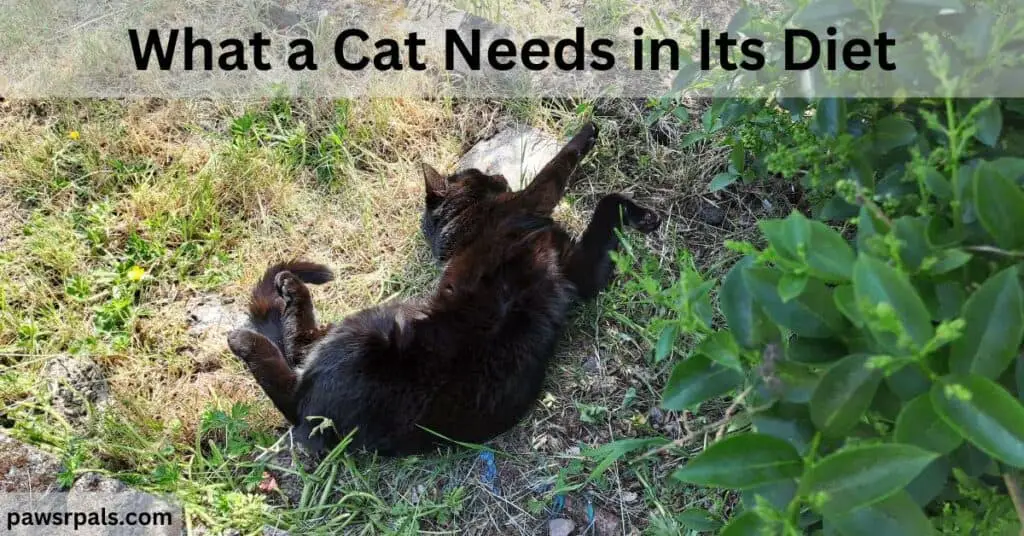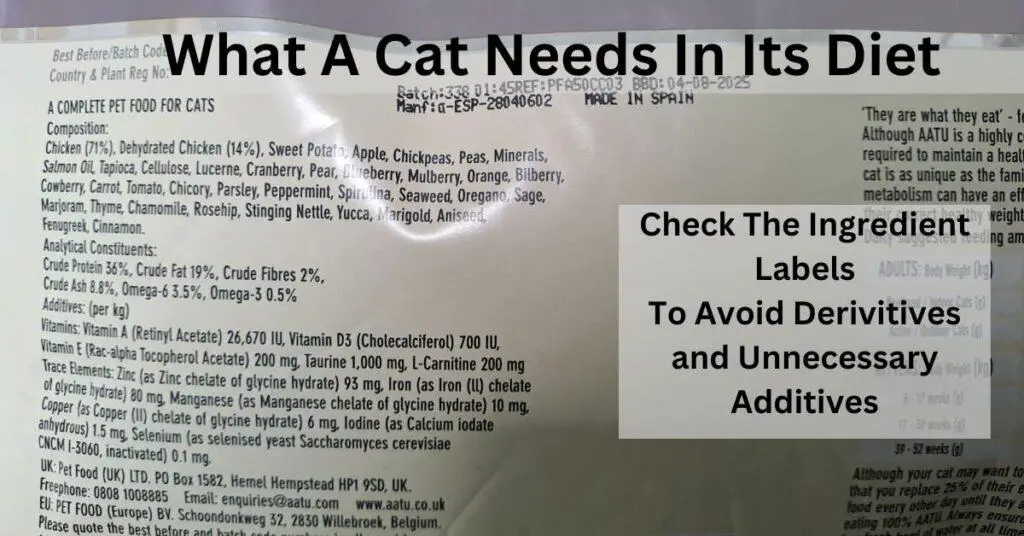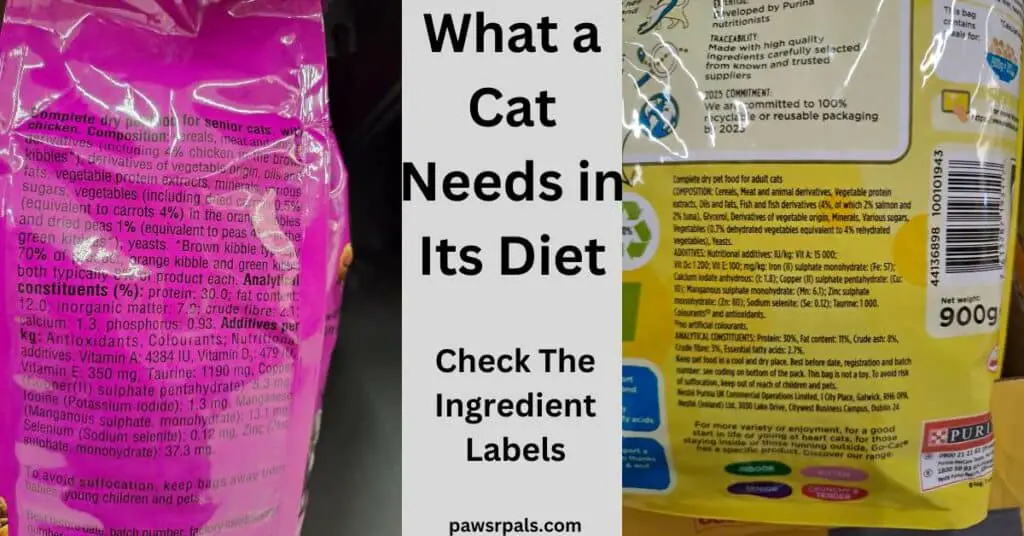Cats are obligate carnivores; therefore, they need 55% protein, 43-44% fat, and only 1-2% carbohydrates in their diets to maintain their health.

Cats and Protein
Cats use the protein from their diets to create amino acids that their bodies do not synthesize naturally. These amino acids are essential for producing and maintaining proteins that form the cat’s tissues and energy in their cells. If a cat doesn’t get enough animal protein in its diet, its body will cannibalise its own muscle tissues to get them. A lack of animal protein can cause birth and growth deformities, heart conditions, blood clots, immunosuppression, and a risk of blindness.
Protein and Fat Sources for Cats
Good protein and fat sources include poultry (such as chicken, turkey, and duck, although duck is high in fat and should not be given often), beef, pork (high salt content), and veal. Fish should only be offered occasionally (a small amount once a week at most) as some cats are allergic, and modern fishing techniques and pollution mean that fish contain mercury and other heavy metals (this includes organic fish). Omega-3 may have to be given as a supplement (1/2 teaspoon daily) in the diet, as tuna is one of the best sources of omega-3 fatty acids but contains counter-productive pollutants.
Fats are essential energy sources for cats, providing twice as much energy per gram as carbohydrates and proteins. Fatty acids (omega-3 and 6 – too much omega-6 can cause inflammation, skin issues, and weight gain) are necessary for brain development and function, maintaining cell structure, nutrient and nerve transmission, and liver function. It also reduces inflammation, carries fat-soluble vitamins, and maintains skin, coat, joints, and vision, to name a few.
Cats and Carbohydrates
Cats don’t need a lot of carbohydrates in their diet as they get their energy sources from proteins and fats – however, fibre can help get rid of hairballs quickly and aids digestion by reducing constipation. Cats usually get fibre from the contents of their prey’s stomach; however, most commercial cat food contains grains, lentils, and vegetables. Too many carbs in a cat’s diet can impair protein absorption and increase the risk of gum disease, FLUTDs, and diabetes/overweight.
Always check the ingredient label on your cat’s commercial food.

Amino Acids and Cats
There are 11 amino acids that the cat’s bodies cannot synthesize, and these are:
- Taurine (heart function, digestion, immune system, vision, foetal development, and healthy pregnancy).
- Arginine (detoxing ammonia from the body via urine).
- Histidine (produces neurotransmitter histamine, immune and digestive system functioning, skin and coat health).
- Isoleucine (muscle growth and repair, healing wounds, immune function and produces haemoglobin, maintains shiny fur).
- Leucine (maintains muscle mass, and can also be used as an energy source).
- Lysine (helps build muscle, bones and cartilage, aids the immune system, and prevent/treats feline herpes and cold viruses).
- Methionine (builds muscle, helps produce hormones and proteins, and aids detoxing – essential for avoiding stunted growth in kittens).
- Phenylalanine (helps produce protein and enzymes, maintains cell membrane structure, and nerve transmission, converts into tyrosine for thyroid hormone/adrenaline/noradrenaline production, aids in producing melanin – pigment colouring for skin and coat).
- Threonine (necessary for healthy skin and muscles as it produces collagen and elastin, preventing bone loss by helping absorption of calcium and phosphorus).
- Tryptophan (precursor for the neurotransmitter serotonin, which regulates sleep and mood).
- Valine (maintains and repairs muscle tissue, aids digestion and lowers blood sugar levels, produces growth hormones, maintains healthy coat).
There are some non-essential amino acids that cats can naturally synthesize. These are:
- Alanine (metabolism and energy production, build and repair muscle).
- Aspartic Acid (muscle and nervous system function, immune system, energy production).
- Cystine (coat maintenance, nutrient absorption).
- Glutamic Acid (nervous system development and operation, metabolising proteins).
- Glysine (synthesises proteins, enzymes and other molecules).
- Proline (development and maintaining muscles).
- Serine (protein synthesis, metabolism and energy production).
- Asparagine (breaks down ammonia in the cells and produces neurotransmitters).
- Tyrosine (a component of neurotransmitters and thyroid hormones, can be synthesized from phenylalanine).
- Selenocysteine (necessary for various cellular processes).
During metabolism, amino acids and enzymes work together – Enzymes are proteins that help change how amino acids work. Catabolism is the breaking down of complex molecules into simpler ones – ammonia is produced during this process – however, obligate carnivores (cats) have an increased risk of ammonia toxicity because they require a high-protein diet to survive.
Using Supplements in a Cat’s Diet
Every cat is an individual, and their needs will always vary. I would always advise you to speak to your vet for a personal diet plan or if your cat has specific needs. Your vet knows your pet and can give your cat a thorough checkup and suggest the best type of food or additional supplements it may require.
I would not advise supplementing your cat’s diet without consulting your vet. Over-supplementing can cause more harm than good.
Last Word on What a Cat Needs in Its Diet
Your budget will greatly affect what food you buy for your cat. Some cheaper commercial cat food doesn’t contain what your cat needs to maintain its health. However, opting for a middle-range food can often work out more cost-effectively, as it will mean fewer trips to the vet, and your cat will be in better health. If you can afford to top up your cat’s cheaper food with little bits of cooked meat, like chicken or beef (and it will only be little bits of meat), that will benefit your cat too.

It’s always a good idea to check the ingredient label, looking for derivatives and determining the amount of carbohydrates and additives included. This will give you an idea of how nutritious the food is.
I have written an article Understanding Dog Food Ingredient Labels – even though this article is for dog nutrition, the terminology also applies to cat food ingredient labels.

Leave a Reply